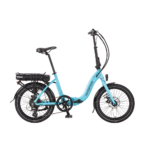I'd guess they're 2SK4145'sBinlow, out of interest, what is the part number on the MOSFETS? The component that looks like a MOSFET on the end is a voltage regulator, but can't see the codes on the MOSFETS.
Hub motor swap from Bafang to MXUS
- Thread starter Binlo
- Start date
The issue is the controller mosfets and their temperature rating, when they reach this they reach the thermal overload and temporarily short out/cut out. Once they cool a again they are fine until it happens again if they don't fail altogether.
The weight, uphill terrain. riding with max current loading and slow speed doesn't take long for the mosfets to reach the temperature ceiling. One can try extra heat sinks, fan cooling or opt to replace with a bigger controller and more mosfets.
The weight, uphill terrain. riding with max current loading and slow speed doesn't take long for the mosfets to reach the temperature ceiling. One can try extra heat sinks, fan cooling or opt to replace with a bigger controller and more mosfets.
If a wire comes adrift, the motor can't turn, but you get maximum power down the remaining complete phase. You must never give full power to an electric motor when it isn't running properly. I've seen photos of the aftermath, though I can't remember a single incidence on this forum in the ten years I've been on it. I would have expected it to be a bit more common because its's easy to stretch the bullet connectors or not fully insert them, so I guess you have to hold full throttle for quite a while before it burns enough to fail.That's what I expected, although sounds worrying about the phase wire disconnection. Is that from a controller failure, or just a wire coming adrift?
I suppose in some factories they have someone sitting there with a soldering iron trying to "tune" the shunt. All the controllers I've taken apart and BMS units with shunts have been clean.
This is the clearest picture I was able to get for the numbers stamped on the Mosfet. Maybe you may now what make and type this is from your experience .. I'm still a newby .. lol !Binlow, out of interest, what is the part number on the MOSFETS? The component that looks like a MOSFET on the end is a voltage regulator, but can't see the codes on the MOSFETS.
Attachments
-
720.8 KB Views: 17
Hey Wheezy, I think I found the Mosfets used in my controllerThis is the clearest picture I was able to get for the numbers stamped on the Mosfet. Maybe you may now what make and type this is from your experience .. I'm still a newby .. lol !
This is the clearest picture I was able to get for the numbers stamped on the Mosfet. Maybe you may now what make and type this is from your experience .. I'm still a newby .. lol !
I use a magnifying glass to read the numbers on mine. It's helpful if you can find out the number then you can look up the specs for them.
The one on the end (LM317) is a voltage regulator, not a MOSFET. The MOSFETS are the 6 components to the right.
Did your controller have thermal paste on the small heatsink connecting the MOSFETS to the case?
I've found most do not and so heat conduction to the case is poor.
Ak ok, they were all blank as far I can remember, that now makes sense why there was 7 of those , as normally the mosfet's comes in pairs right? A neg and pos pair.I use a magnifying glass to read the numbers on mine. It's helpful if you can find out the number then you can look up the specs for them.
The one on the end (LM317) is a voltage regulator, not a MOSFET. The MOSFETS are the 6 components to the right.
Did your controller have thermal paste on the small heatsink connecting the MOSFETS to the case?
I've found most do not and so heat conduction to the case is poor.
It had very little paste, like a greyish dust came off my fingers. Should I buy a tube of thermal paste and try putting some on?
I am concerned that the controller does not damage my new MXUS motor or am I pretty much safe to try it out again before new controller comes, the same one Ross recommended as he has the same bike as mine?
Ak ok, they were all blank as far I can remember, that now makes sense why there was 7 of those , as normally the mosfet's comes in pairs right? A neg and pos pair.
It had very little paste, like a greyish dust came off my fingers. Should I buy a tube of thermal paste and try putting some on?
I am concerned that the controller does not damage my new MXUS motor or am I pretty much safe to try it out again before new controller comes, the same one Ross recommended as he has the same bike as mine?
Ok, it's annoying when they do that and then you can't look up the specs.
A bit of thermal paste would help, but don't overdo it, you don't want it too thick either, a nice thin even layer.
I would ride carefully and not push things for now and keep an ear out for strange sounds/vibration.
Hey All, A quick update!Ok, it's annoying when they do that and then you can't look up the specs.
A bit of thermal paste would help, but don't overdo it, you don't want it too thick either, a nice thin even layer.
I would ride carefully and not push things for now and keep an ear out for strange sounds/vibration.
I managed to take the bike out with the new MXUS motor installed and done nearly 20 miles with not a single problem, the bike just worked when I needed motor assistance. So it has to be the old Bafang motor that has developed the fault, I must have over loaded it with my son on the back. As before I started putting him on the bike it was working with no issues.
So perhaps the issue was with the motor and not the controller after all ..
Now can I repair this motor is the million dollar question .. lol
No, how do you perform that test?Have you done a hall sensor test yet ?
Put a multimeter on the hall sensor wires, one at a time with the controller switched on and you should see each one switching from 0V to 5V and back again as it senses a magnet going past.No, how do you perform that test?
Red & Black hall should show 5v with meter set to 20v, bike battery connected and on. Probe then on the Black hall and in turn the Red probe to the three coloured halls, one should see the voltage switching as one rotates the wheel slowly backwards.No, how do you perform that test?
Hey all, I have now cancelled my order with pswpower as it looks like the controller was not at fault at all. It was actually the motor. BTW, the new mxus motor is good, seems to tackle all the inclines and is upto 350w power too if I want. The bike just works so good now. Although in UK, limited to 250w by original controller.Red & Black hall should show 5v with meter set to 20v, bike battery connected and on. Probe then on the Black hall and in turn the Red probe to the three coloured halls, one should see the voltage switching as one rotates the wheel slowly backwards.
So I know you want me to test the hall sensors on the old Baang motor, however the bit that puzzles me is why does the motor operate without any issues until it has to deal with some load. I would have thought that is the hall sensor is failing that the motor would not work smoothly or be jerky that you cannot ride?
Also when testing , are you saying to have the motor opened up and the probe it whilst the motor is connected via the 9 pin wire to controller etc?
No.jerky that you cannot ride?
Also when testing , are you saying to have the motor opened up and the probe it whilst the motor is connected via the 9 pin wire to controller etc?
You test via the controller if it has a hall wire block by poking the probes in to the rear.
Hey all, I have now cancelled my order with pswpower as it looks like the controller was not at fault at all. It was actually the motor. BTW, the new mxus motor is good, seems to tackle all the inclines and is upto 350w power too if I want. The bike just works so good now. Although in UK, limited to 250w by original controller.
So I know you want me to test the hall sensors on the old Baang motor, however the bit that puzzles me is why does the motor operate without any issues until it has to deal with some load. I would have thought that is the hall sensor is failing that the motor would not work smoothly or be jerky that you cannot ride?
Also when testing , are you saying to have the motor opened up and the probe it whilst the motor is connected via the 9 pin wire to controller etc?
Good that the system seems to be working with the new motor and you are up and running.
Strictly speaking, if the rear motor is rated 350W, it is not legal for use on the road in the UK and I doubt that the controller is limiting it to "250W". Is there actually a "250W" restriction switch on the controller?
The controller will supply the motor with 36V (nominal) at up to 15A, so about 540W and the motor will just use what's available to it.
At the end of the day, it's never likely to be a problem, the police are not going to bother stopping you etc, but if you were involved in an accident, they would look at the 350W marking on the motor and you would be in the sh*t, riding an unregistered, uninsured vehicle without an MOT etc etc.
The law is a load of BS, as that same motor is probably badged as "250W" for sale in other markets.
Anyway, back to testing your other motor. If you have Julet connectors, it can make things tricky. You can get adaptor cables, or improvise your own, or if you can access the controller, carefully probe the voltages from there.
Ah, Nealh beat me to itNo.
You test via the controller if it has a hall wire block by poking the probes in to the rear.
With the Bafang motor, does it spin freely by hand, is there any unusual noise?
It would be interesting to try this motor on another controller to see how it behaves.
Hall sensors work independently from the load on the motor. They're on a completely different circuit to the motor power, so are not influenced by power or speed. The only logical fault for a hall sensor with your symptoms would be something like a wire not tied down properly and it's rubbed on the motor and worn through its insulation, which probably wouldn't show during testing if the motor always starts. It's much more likely that your problem is related to the phase wires, but that would be very unusual, except for faulty connections or damaged cable.
Thanks, the bike is so much fun. The motor is from 250w - 350w, so are you saying that the motor will be still working at 350w even though I can limit the speed down to 15.5MPH , the legal speed for ebikes in the UK. The motor has no badging of power, just says MXUS on the hub and model number on the side. Nothing about power output.Good that the system seems to be working with the new motor and you are up and running.
Strictly speaking, if the rear motor is rated 350W, it is not legal for use on the road in the UK and I doubt that the controller is limiting it to "250W". Is there actually a "250W" restriction switch on the controller?
The controller will supply the motor with 36V (nominal) at up to 15A, so about 540W and the motor will just use what's available to it.
At the end of the day, it's never likely to be a problem, the police are not going to bother stopping you etc, but if you were involved in an accident, they would look at the 350W marking on the motor and you would be in the sh*t, riding an unregistered, uninsured vehicle without an MOT etc etc.
The law is a load of BS, as that same motor is probably badged as "250W" for sale in other markets.
Anyway, back to testing your other motor. If you have Julet connectors, it can make things tricky. You can get adaptor cables, or improvise your own, or if you can access the controller, carefully probe the voltages from there.
Okay I will do that next time I have the controller out again.
Thanks for all the assistance
Yes, it frees without any issues etc and no noises at all. When the motor starts to play up the current peaks out at 5 bars on display and motor does not spin, or just overspins internally as the wheel does not turn. Cannot even perform walk mode.Ah, Nealh beat me to it
With the Bafang motor, does it spin freely by hand, is there any unusual noise?
It would be interesting to try this motor on another controller to see how it behaves.
Yes , that is a good idea but for now I will stay with the new motor and if I ever do change the controller then will give this a test to see what happens. I think bottom line is I may have over cooked the motor or its windings when they heat up etc.
Related Articles
-
 MTF Enterprises announces acquisition of EMU Electric Bikes
MTF Enterprises announces acquisition of EMU Electric Bikes- Started by: Pedelecs
-
 Wisper 806T folding bike wins Which? ‘Best Buy’
Wisper 806T folding bike wins Which? ‘Best Buy’- Started by: Pedelecs
-
 Sustrans calls for protected cycle lanes
Sustrans calls for protected cycle lanes- Started by: Pedelecs
-
 Amazon launch their first UK e-cargo micromobility hub
Amazon launch their first UK e-cargo micromobility hub- Started by: Pedelecs



